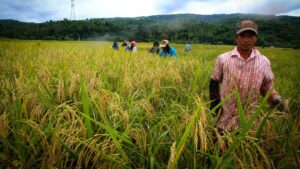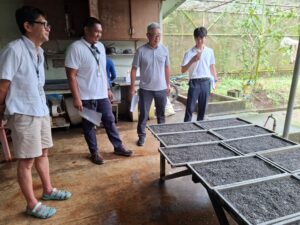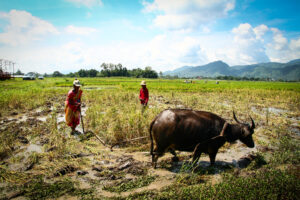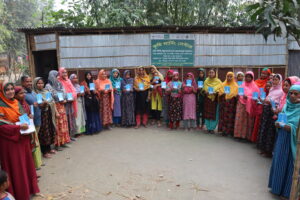Annually, Bangladesh consumes about 2.9 million metric tons of urea and about 60% of this is used in rice cultivation. Therefore, this could contribute to increasing atmospheric pollution due to increased CH4 and N2O emissions. Increasing nitrogen-use efficiency by adopting urea deep placement (UDP) could reduce environmental pollution including mitigation of GHG emissions compared to conventional nitrogen management through broadcasting method or the adoption of integrated plant nutrient system. Moreover, UDP could be more effective in mitigating greenhouse gas emissions when it is combined with alternate wetting and drying irrigation.
Nitrogen (N) fertilizers play a critical role in increasing rice productivity. However, current N fertilizers (mostly urea) management practice in Bangladesh is not efficient as most farmers apply fertilizer through broadcasting method. As more than 50% of applied N fertilizer is lost from soil-plant systems to the environment, broadcasting contributes to pollution of air and groundwater due to increased N losses through ammonia (NH3) volatilization, surface runoff, nitrification and denitrification, and leaching and lower nitrogen use efficiency (NUE). Moreover, inefficient N application could increase CH4 emissions.
Annually, Bangladesh consumes about 2.9 million metric ton of urea and about 60% of this is used in rice cultivation. Therefore, this could contribute to increasing atmospheric pollution due to increased CH4 and N2O emissions. Previous literature reported that changing N application from surface broadcasting to sub-surface (or root-zone) application substantially reduces N losses, and GHG emissions.
UDP could reduce CH4 emissions due to increase O2 availability in the rhizosphere that enhance CH4 consumption but increase N2O emissions due to increases in microbial nitrification of NH4+ and subsequent denitrification of NO3−. In contrast, urea deep placement (UDP) could mitigate N2O emissions since it retains N in soils as non-exchangeable ammonium (NH4+) for a longer time.
This helps to supply N throughout the rice-growing season and a negligible amount of NH4+-N diffuses from reduced zone to the soil surface or floodwater. However, it could promote CH4 emissions through the enhanced CH4 transport pathway from the soil to atmosphere due to improved root and shoot growth of rice and providing more carbon substrate for methanogenesis.
The contradiction among these results may arise from the variations in the source and amount of N fertilizer, soil, climate conditions, and their interactions. It is not clear whether UDP in rice cultivation mitigates or increases the total GHG emissions (CH4 and N2O) across different water regimes. Therefore, further research is needed to identify the effect of UDP on GHG emissions from the rice field, particularly with alternate wetting and drying (AWD) irrigation across the country in order to understand the environmental benefits of UDP by raising awareness of farmers and policy makers on importance of water saving irrigation on protecting environment.
Water-saving irrigation AWD is becoming popular as it could be effective in mitigating total GHG emissions from irrigated rice fields. Moreover, AWD irrigation getting popular due to increasing scarcity of irrigation water. In Bangladesh, it is reported that groundwater table is declining due to continuous extraction for irrigating for boro (dry season) rice. AWD irrigation saves water by up to 38% without significant yield loss.
Although AWD irrigation increases N2O emission due to increased nitrification during drying period and denitrification during wetting period. In contrast, under continuous flooding, N is retained in the form of ammonium, thus there is less availability of nitrate N for the denitrification. However, the increased N2O emissions could be offset by reduced CH4 emissions as N2O emissions contribute ≤5% to the total GWP in rice cultivation. Therefore, both UDP and AWD irrigation are considered climate-smart technologies in rice cultivation as they are effective in reducing GHG emissions and increasing farm profits.
Similarly, the incorporation of organic inputs increases organic carbon (OC) reserves in the soil, thereby improving soil fertility and crop productivity and also affecting GHG emissions. As organic inputs contain lower levels of nutrients compared to inorganic fertilizer, they are often applied in combination with inorganic fertilizers, with the ratio depending on the availability of organic inputs.
The model of combined application is called integrated plant nutrient system (IPNS). One of the locally available organic inputs, which is widely used in Bangladesh, is poultry manure. This provides readily available carbon (C) and N to the soil that act as additional substrate for methanogens and nitrifying-denitrifying bacteria, resulting in higher amounts of CH4 and N2O emissions.
In IPNS, the supply of C and N is sustained for a longer period due to slow mineralization, thus improving crop growth through effective tillers and increasing rice yields. However, the effects of integrated plant nutrient system (IPNS), particularly the combined application of prilled urea and poultry manure on GHG emissions are not well documented. More research is thus needed to investigate the impacts of IPNS on rice yields and emissions under different irrigation regimes. This type of studies helps to increase understanding on the environmental benefits of fertilizer treatments in combination with water regimes so that public awareness and decision making by policy makers about carbon-friendly farming could be increased.
This current study investigated the effects of UDP and integrated plant nutrient system (IPNS) treatment as well as their interaction with irrigation regimes such as AWD and continuous flooding (CF) on GHG emissions, rice yield, and nitrogen-use efficiency (NUE). It is hypothesized that UDP with AWD irrigation could mitigate GHG emissions compared to broadcast prilled urea and IPNS treatment with CF irrigation. To test this hypothesis, multi-year field experiments were conducted in Bangladesh to determine the impacts of UDP and IPNS amendment across different irrigation regimes on GHG emissions, rice yield, and NUE.
This study confirms that increasing nitrogen-use efficiency by adopting improved fertilizer application method (urea deep placement, UDP) could reduce environmental pollution including mitigation of GHG emissions compared to conventional N management through broadcasting method or the adoption of integrated plant nutrient system (IPNS). Moreover, UDP could be more effective in mitigating GHG emissions when it is combined with AWD irrigation compared to continuous flooding (CF) irrigation.
Similarly, UDP could reduce greenhouse gas intensity (GHGI) compared to conventional urea application or IPNS treatment. While comparing irrigation regimes, our results confirm that AWD irrigation could reduce GWP and GHGI without affecting NUE and yields compared to CF irrigation. Our findings suggest that adoption of UDP with AWD irrigation is effective in mitigating GHG emissions from rice based cropping system with similar soil types and management practices adopted in this study. Therefore, policy makers should develop strategies for wide-scale dissemination of both AWD and UDP technologies so that the country can mitigate GHG emissions while increasing NUE, and rice yield.
Read the study:
Mofijul Islam SM, Gaihre YK, Islam R, Ahmed N, Akter M, Singh U, Sander BO (2022) Mitigating greenhouse gas emissions from irrigated rice cultivation through improved fertilizer and water management. Journal of Environmental Management, Volume 307






For #Rice growing #Drip_Irrigation has proven to be more effective than all traditional irrigation methods – standing water or alternate wet & dry irrigation method.
We #JainIrrigation has done fundamental work on growing Rice with Drip – See link;
jains.com/temp/RiceJainT…
#MoreCropPerDrop #TransformingLives